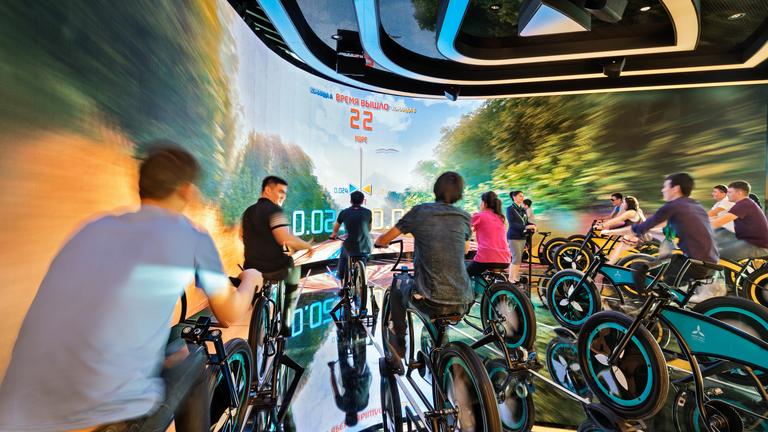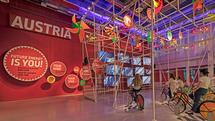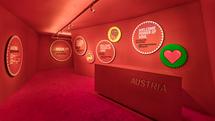Expo 2017, Astana/Kazakhstan
| "Astana Sphere" |
|
| "German Pavilion" |
|
| "Energy Best Practice" |
|
| "Austrian Pavilion" |
|
| "Shell Pavilion" |
|
| Date: | 10th June to 10th September 2017 |
| Location: | Astana, Kazakhstan |
| Services: | Video, Audio, Lighting, Rigging, Event-IT(electrical and network infrastructure) |
| Project Managers: | Jens Gießler and Felix Erdmann |
| Local Coordinator: | Evgeniy Davydov |
| Branch Offices: |
|
| Special Features: |
|
The slogan of the world's fair was "Future Energy: Action for Global Sustainability". The focus was on a sufficient and reliable supply of energy in developing countries as well as on the transition from fossil fuels to renewable forms of energy. We were responsible for realising five Expo projects.
360° projection and the "Wall of Future" in the "Astana Sphere"
Our team was responsible for a major part of the "Astana Sphere". Officially named "Nur Alem", the world's largest self-supporting glass sphere was the pavilion of the host country, Kazakhstan. Each of the eight levels of the "Sphere" focused on a form of regenerative energy. The "Wall of Future" served as an architectural connecting element, which we realised with 800 seamless displays (55") providing information on each of the various topics.
In the interior of a walk-through solar sphere measuring 13 metres in diameter, visitors encountered a 360° projection, which we realised with ten 30K plus four 13K laser projectors. We used LED floodlights, projections and printed elements to simulate activities on the surface of the Sun. Performers manipulated the "Wheel of Life" during the "Kinetic Energy Show" on Level 3. This effect was realized by 38 moving lights that had been programmed in a time-code-controlled show sequence.
Multimedia experience in the German pavilion
"Energy on Track" was the slogan of the German presence. The focal points of the exhibition concept were a high-quality implementation of the media technology for the exhibits as well as extensive support, which we provided throughout the entire exhibition. In order to underline the first-class visual impression, we opted for special installation lights and produced bespoke parts, which our team then carefully installed with a keen eye for detail.
After exploring the "Map of the Future" and "City of the Future" exhibition areas, visitors experienced an interactive highlight, which we realised together with numerous partners. A multimedia experience was developed from "energy points" previously collected by means of RFID smart sticks: a round table, six meters in diameter, stood in the centre of the twelve-sided room, which we used as a projection surface for a twofold 4K soft edge projection. From a recess in the middle of the table, laser beams were directed onto six further projection surfaces on the outer walls of the rooms by means of a mirror sculpture installed above to enable an interactive experience. The result was an impressive 360° presentation, further augmented by our 3D audio installation.
Our logistics specialists brought five trailers of equipment from Germany to Astana prior to commencement of construction to equip the pavilion with modern 4K laser projectors and other AV equipment in line with German quality standards. Challenge for our logistics crew: only one service provider had been licensed to deliver supplies to the national pavilions. Due to the heavy workload, in some cases our load only reached its final destination after a wait of several days. It was only through fast and close collaboration between all the disciplines involved that we were able to make up for lost time and meet the deadline for completion.
Nine kilometres of LED strips for the "Energy Stream" light sculpture
The "Energy Best Practice" pavilion - divided into six different thematic areas - was the symbolic centre of the Expo; it presented pioneering technologies as well as a wide range of different forms of sustainable energy. The "Energy Stream" light sculpture was the connecting element running over two floors. It was formed by 30 parallel splines made of a total of 9,000 metres of RGB-LED FlexStrips. We were able to control each pixel individually, and animated content was displayed using pixel-mapping software.
We developed and planned the entire control system in-house especially for this project, whereby some of the components were bespoke products manufactured to our specifications. A glassfibre network with redundant design formed the backbone of the control system. We installed 30 high-performance access points for a stable WLAN for the app with which visitors were able interact with exhibits and access information.
As the client in this project was a public body, we had to carry out our work in full compliance with local standards and Kazakh regulations while documenting everything thoroughly so that the work we had done could be approved by the country's inspection bodies.
Austrian pavilion and Shell presentation
Our other tasks included technical support for Shell's presentation as well as for the Austrian pavilion, which featured a very minimalistic design and focused on visitor interaction with the exhibits. White power rails and appropriate lights discreetly accentuated the action areas. Our responsibilities also included realising the greatly reduced lighting design as well as creating an appropriate infrastructure and designing and realising the Event IT.
Expert coordination of international on-site team and local network
An 80-strong international team with local knowledge, supported by a number of our branch offices, implemented the technical side of the presentation. In his role as "Local Coordinator", Evgeniy Davydov was in charge of organising and supervising the local network of suppliers, technicians and subcontractors. Evgeniy is our project manager responsible for our Eastern Europe business.































